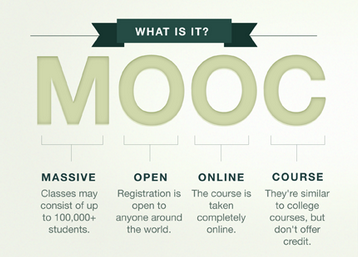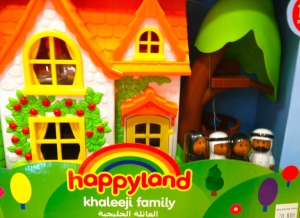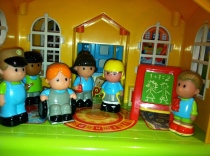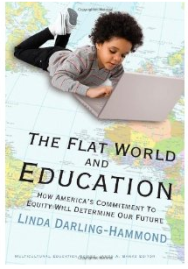Check out our new site www.edspired.org
To Strengthen Educator Relationships, Transparency is Key
“Leadership is unlocking people’s potential to become better.” ~ Bill Bradley
My organization, EDspired, has been collaborating with a PK-3 school to develop and implement a comprehensive teacher professional growth and evaluation process. It is through this collaboration that I discovered and recommended implementing TeachBoost’s instructional leadership platform.
After an unexpected change in leadership during second semester, the assistant principals are now serving as interim principals and I am serving as their leadership coach.
My team had a key decision to make regarding evaluation: Pick up where the former school leader left off and continue the processes that were in place, or start with reminding the staff of the importance of the what, how, and why of teacher evaluations. This often allows for more ownership and understanding of the process.
Typically, we would start with the WHAT:
- Implementing the teacher evaluation and growth process with fidelity
After that, we’d move on to the HOW:
- Pre-observation document
- Observation schedule
- Post-observation conferences
And sometimes, we’d discuss the WHY:
- Observations are important because they are the best way to offer contextualized, constructive, meaningful feedback rooted in the evidence of actual classroom practice.
Then I saw this quote on Twitter’s #tchat: “Great workplaces often share a sense of transparency and empowerment, they want employees to feel invested and informed.” This sparked some new thinking on my part on how I can support the school leaders with their work. I remember learning about Sinek’s Golden Circle, and realized, we must always start with why.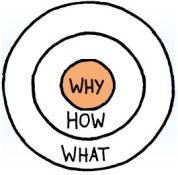
To create change, we need to inspire the teachers. In an effort to build relationships with staff, transparency is key.
So in this case, we started with the WHY. As a leadership team, a few of the questions we discussed to really dissect the WHY were:
- Why is the evaluation process important and how can we communicate this with the teachers?
- Why will the teachers sometimes see more than one administrator in their rooms at the same time?
- Why is it important for the school to have a common language when discussing teaching and learning?
- Why will excellent teaching lead to higher achievement with students?
To create change, we need to inspire the teachers. In an effort to build relationships with staff, transparency is key. It also happens to be one of TeachBoost’s core values, so using their tool introduced greater visibility and accountability into the observation and development process.
We are starting with the end in mind and expect to get more teachers to truly take ownership once they understand that the purpose of our professional growth and evaluation process is to ensure teacher quality and promote professional development. We want to move towards using this concept of the Golden Circle in everything we do to create positive change and inspire the staff.
We will get feedback from staff in the fall as to their perceptions and experiences of the process and how to make sure we get it right this time. Stay tuned!
My First MOOC
I have heard this term very often in the recent months. Every time it came up I needed to look it up to be reminded of what it meant! I officially participated in my first MOOC a few weeks ago.
So, what is a MOOC you ask?
I have a K-12 administrative license in Washington DC and needed to make sure that I had enough Continuing Education Units (CEU) to get re-certified. I thought I was being proactive by saving all my certificates from my professional development courses in a folder on my computer. “Renew Admin License” was on my to do list for weeks, even months before I actually stopped to figure out how many hours I earned and how many I still needed. I created a spreadsheet to organize all my hours and GASP, I was little shy of my 200 hours. Additionally, the Office of the State Superintendent’s office requires that you submit your license renewal documentation 90 days in advance! GASP again! My timeline was getting shorter and shorter by the day. To make the process more complicated, I then noticed that I needed an updated background check and fingerprints. I knew I needed to take action on so many levels!
There are many sites that you can choose from when selecting a MOOC (Massive Open Online Course). I decided to enroll with Coursera and I signed up for a 5 week course called Coaching Teachers: Making Changes that Stick, which was sponsored by Match Education. In my current role I have the privilege of coaching teacher leaders and administrators and I know Match has a very fine reputation, so I eagerly signed up.
I completed an online course many moons ago when I was in grad school and thought it was amazing back then that I could participate in class from my couch! The old version of online courses or distance education was still very didactic to me compared to this MOOC.
What I really liked about this specific MOOC through Coursera was:
- Commitment – Approximately 2-4 hours of work per week
- Medium – There were videos to watch, an article to read after watching the videos, an opportunity to chat with hundreds or thousands of people taking the class and a quiz weekly. The videos were very helpful and made the reading really come to life. There were multiple-choice questions posed visually while watching the videos to also check for understanding along the way.
- Accessibility – I had the option to use a web browser from my laptop or download the app on my iPad. Additionally, I loved that I had the option of closed caption while watching the videos, as I sometimes need to read and watch at the same time (UDL principal of representation in action).
- Application – The final week was about applying what I learned as well as completing a peer review of four other participant’s work and scoring using a rubric.
The information and resources from the course was so helpful and timely that I have referenced it to many people in my work following completion of the MOOC. I am looking forward to finding another MOOC in the near future whether it is directly related to my work or something completely new that I want to learn more about. I appreciate having access to high quality content how and when I want it.
#EDhead #lifelonglearner #instantgratification #EDspired #MOOC
Giving Thanks
I had the great pleasure of visiting a variety of schools this past month. I love to capture what I see, hear, and experience especially in the hallways and when no one knows I am observing! I should have taken pictures or videos, but I didn’t want to ruin the moment and not be fully present during my visits. I am thankful for the educators who are the models for why we choose to do this difficult work on a daily basis. We spend a lot of time “teacher bashing” – we need to celebrate educators more and on a more frequent basis!
Here are some highlights:
- watching young children (3-6 year olds) eagerly choose a book to read while waiting in the lobby to be picked up and invite their friends to come read with them
- teachers chatting after school in the hallway about their day with smiles on their faces and talking about their kids with passion and love
- staff interacting with parents in the hallways during dismissal, knowing every parent by name and knowing specific details about their children
- working with teacher leaders that are excited about coaching – when establishing expectations for our meetings, one fellow said, “outside of the box thinking” – what a fabulous norm. We should always be thinking differently and I hope to foster that.
- observing a Socratic Seminar in a middle school where the teacher is truly facilitating or observing from the sidelines and students own the process
- observing an elementary school math lesson where students were working in small groups and enthusiastically talking about math
- listening to young entrepreneurs from the middle east share how they are working to change the trajectory for youth in their countries
- facilitating professional development sessions at a Common Core conference with educators in Dubai, UAE who were so gracious and invested in learning new strategies
As a school principal, I would capture the good that I saw in children, teachers and even parents and guardians. I made it a priority send a hand written note (at least twice a year) in the mail thanking someone for something they had done to impact the life of a child in our school. Although it seems like such a minor gesture, my staff was always grateful to be acknowledged in that way. Don’t get me wrong, I always had chocolate in my office as well!
How do you thank those that are making an impact in your school? How would you like to be acknowledged?
Appreciating Diversity
I was browsing in a toy store at the Dubai Mall looking for some educational type gifts for my nephew and I stumbled upon this…
At first I laughed, took a picture, and sent it to my family. I was actually really impressed with what I saw and annoyed with myself that I laughed. For many families living in the GCC this is their reality even if they don’t come from a gulf (Khaleej) family. This traditional dress is what all expat and local kids see in their communities daily. In Dubai, local women traditionally wear a black abaya and men wear a white kandura (dishdasha).
As I reflected on upon my initial reaction, I realized that growing up in the USA, I never saw these toys in the toy store. I never saw a toy or doll that looked like me or my family.
A little more poking around led me to this:
I was very impressed with these toys, and looked them up and found that they are made by a company based in the UK called elc. I would love to see these types of toys in a center in an early learning classroom.
“Another way to ensure diversity in children’s lives is to choose toys, books and media that reflect all types of people (e.g., include images of people with a variety of backgrounds, ages, abilities, characters that break stereotypes about men and women, art supplies in a wide range of skin, eye and hair colors). “
(Bias-Free Foundations: Early Childhood Activities for Families, 2001)
How are you ensuring diverse experiences and materials for your students or children? Comments welcome.
Building Bridges
I love my dad. Recently, we have been working very closely together on a major project. During this collaboration, we have had to overcome numerous obstacles on how to better communicate through the use of technology. My dad is a businessman – very serious, linear, a CFO type. While on the other hand, I am an educator – passionate, a dreamer, focused on doing things more efficiently and making sure everyone learns through the process.
Currently, we live on different continents; so “collaborating” is no easy task. Initially, we started out simple: smartphones, WhatsApp, and phone calls. Then we progressed to Skype – since there is no need to pay for calls when we can talk for free! Skype was funny and Dad had lots of questions. But after the first few times, he quickly became a pro.
The next layer of this digital adventure was teaching Dad how to share his screen. This way, I could see what he is working on, and vice versa. To add to the confusion, I have a Mac and Dad has a PC. So sometimes programs look a little different and we had an issue where he couldn’t remember how to share his screen. When he figured it out, he discovered he has an older version of Skype and needed to upgrade. I decided it was time to introduce him to join.me. This ensured that he could share his screen with anyone, even if they don’t use Skype. I walked him through the process step by step and we were equally impressed with the ease of being able to share a document and work through our thoughts together.
To complicate the above, I created a shared folder in Dropbox and excitedly invited Dad to join. That process is pretty simple and seamless. Every time Dad would change a document, add or delete content, Dropbox would notify me as it was running in the background on my computer. As soon as I would get the notification, then I would receive an urgent text from dad asking: “Can you see the document? Please advise”. I get it, he wanted to make sure it was there. It’s all part of the learning process. He no longer asks me if I can see the document as he has become more comfortable with the use of the program. Good work Dad!
Our next task is finding an online project management tool and we are open to suggestions. Stay tuned for more on this and other stories of adventures through digital learning and collaboration.
Virtual Book Club v2
KDSL and EDspired are teaming up to host our second virtual book club beginning June 18, 2012. We will be reading: The Flat World and Education: How America’s Commitment to Equity Will Determine Our Future (Multicultural Education) by Linda Darling-Hammond.
If you would like to join us, comment below or join the event on Facebook https://www.facebook.com/events/156208597840835/
You can also join directly here https://groups.google.com/forum/?hl=en&fromgroups#!forum/edspired-and-kdsl-virtual-book-club-v2
For more information about the book check out: http://store.tcpress.com/0807749621.shtml
Expectations
“When people are placed in positions slightly above what they expect, they are apt to excel.”
~Richard Branson
I saw the following student work displayed in a 9th grade science class:
I waited for the teacher to turn around before I snapped the pic. I didn’t want her to know that seeing this caused me have an ulcer for the day. This is exactly what I taught my first graders when we were learning about the same topic. Something is horribly wrong here!
Lately, a running theme in my work has been observing urban educators with low expectations of their students. Many times, I don’t even think they realize they are doing it. I have been a part of multiple conversations recently where people use the label “SPED kids” or Special Ed kids”. This terminology makes my skin crawl. We have to look at the child first. People can say it’s all the same thing, but is it? I would rather hear “student with special needs” or a “student with a disability”. I heard a school administrator call a student: “the downs kid” – REALLY??? How about calling a student by name? Or saying the child with Down’s Syndrome? We must stop using these identifiers in this manner.
How can we better model and teach the language and practice of inclusion and tolerance? How do we change the discourse?
Comments welcome
So You Want to Facilitate a Webinar
I participate in many webinars and usually I am disgruntled as I think to myself, why am I participating if the presenter is just reading the sides out loud? This time, I was on the other side of the screen…I was the facilitator…and I bombed! I learned how challenging it really is to facilitate online learning as there are so many moving parts. This experience led me to a metacognitive moment…thinking about my thinking and my process.
1. Practice, practice, practice- don’t just practice what you are going to say, practice using the “virtual classroom space”
2. Make sure your speaker and mic are both ON
3. Provide frequent pauses to read and respond to questions by participants so that it’s as interactive as possible, especially when your audience is only participating through a Q&A box
4. If you are going to use the cursor – use it! Otherwise, it’s a distraction
5. Revisit step one
I <3 Learning
I love learning! Sounds cliché at best, but I really do especially when it’s based on my interests and at my own pace. Quite honestly, the idea of going back to school, especially in a traditional setting, makes me anxious. However, I am obsessed with technology and finding new ways to be more organized and efficient and effective in my personal and professional life. I often imagine what school would have been like for me if I had all the tools and technology that we have today.
My goal is to share resources that I stumble upon and actually use and then share with my fellow EDheads:
I was looking for a way to save bookmarks in an organized manner and one that was not limited to my laptop and stumbled upon Diigo. I have many bookmarks that are organized, but when it comes to looking up a resource, I rarely refer to my bookmarks. It somehow seems overwhelming to have to remember where to look for the information. Additionally, having access to this information through the Internet, is invaluable. I work from different sites and in some cases may not have my laptop with me; this allows me to be global and mobile. Check it out!
http://www.fractuslearning.com/2011/12/07/convince-your-school-diigo-rocks/



